23rd October 2007
 Monday, November 19, 2007 at 03:40PM
Monday, November 19, 2007 at 03:40PM No sign of the buffalo carcass or the crocodiles or even any scavenging birds this morning. I think overnight the last of the spoils would have been torn apart by the crocodiles, each piece the eaten as it drifted downstream, leaving nothing at all to see by morning.
Bit by bit, I’m going to introduce you to our house. Today I had fun photographing our bathroom – notably our “loo with a view” – I photographed both perspectives, looking in at our “throne” and the reverse angle, looking out while seated! The only thing is, you've got to remember to tuck in the end of the loo roll, otherwise the whole thing unravels in the wind . Plus our shower with all its unique fittings (note the shower rose in particular) and our spectacular bath – which doubles as a cooling plunge pool at midday – overlooking the river. Surely that’s got to be one of the most special baths in existence?
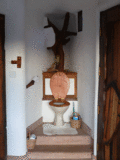
Loo with a View
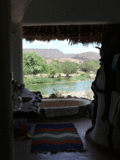
View from the Loo
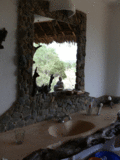
Bathroom Basin & Mirror
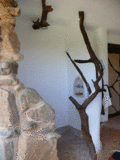
Open-Air Shower

Shower Rose
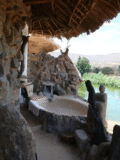
The River Bath
We’ve only been living properly in our house for about a month or so, but the longer we live in it, the more the house comes into its own, especially as our built-in flower beds (which border our upstairs balcony, as well as the rooftop) start to bloom.
See more photos around and about our house...
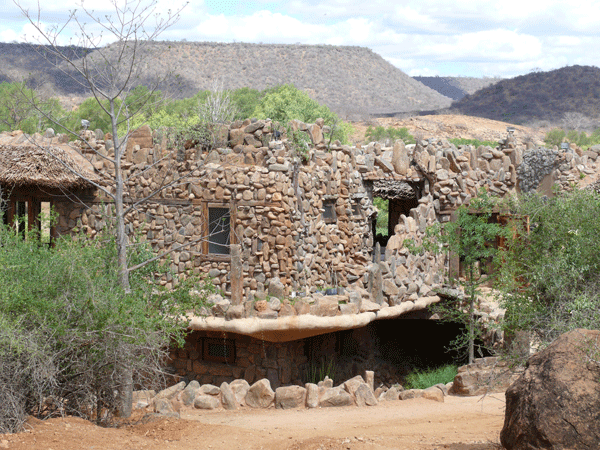
By watering the trees around the house, really encouraging the vegetation to flourish, and planting greenery around and about, the view of our house from the rear has already changed dramatically from even one month ago – it seems to blend in much more with the surrounding environment. As we nurture our young garden, both inside and outside the house, our policy is to use only plants, which are indigenous to Kenya - specifically to this part of Kenya, if we can.
We have one particular succulent, which is the cause of much wonderment to us – it seems to reproduce by cloning itself. Each fat juicy leaf has a serrated edge (not unlike a crocodile’s tail in appearance!), and on each tip of the serrated edge forms a miniature replica of the adult plant. When the wind blows or the rain falls, these tiny clones fall off the adult plant and set down their own root systems, ultimately growing into an adult plant, and starting the process over again with their own clone-edged leaves.
We’ve planted these incredible plants in several places – in the flowerbed just by our bedroom door, in the flowerbeds which surround our bath tub (where they are flourishing) and I’ve also recently planted some small ones along the ramp leading up to our front door. It will be fun to see how quickly they grow, helped along by regular watering, of course.
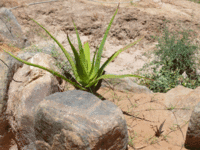
Aloe & 'Baby' in Balcony Flowerbed
I’m also enjoying seeing my aloes take root and flourish. They were red from lack of water when I first planted them six weeks ago, but they have turned green now and look gorgeous in our upstairs flowerbeds, framing our balcony and adorning our flat rooftop. One has already sprouted a baby – a tiny brand new aloe has grown from the extended root of the parent. Our sanseviera, which we have planted in several places around the outside of the house, as well as under the stairs leading to the roof (being shade-loving plants) also reproduce in this way – by sending up new shoots from their root systems.
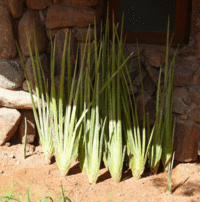
Sanseviera robusta behind guest bedroom
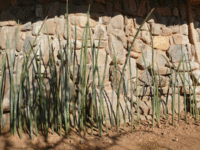
Riverside Lawn Sanseviera
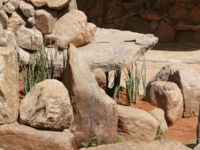
Small Sanseviera beneath Kitchen
See more plants and flowers in our balcony flowerbeds & gardens...
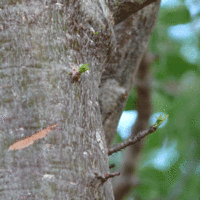
Leaf shoot from Baobab trunk
I was examining our baobab transplants this afternoon – these are the baobab trees which we brought in by tractor from neighbouring properties so that over time (like in another one hundred years!), there will be a magnificent baobab forest at the back of our house. In the shorter term, we will watch these stubby wonderful trees grow, with the aid of regular watering, and see them flower in all their delicate white and yellow beauty…anyway, I digress: while I was examining our baobabs, I noticed some of them were sending out new leaf shoots – not just from the end of their branches, but from the main trunk of the tree, which I thought was quite unusual and worth mentioning. (Follow the story of all our trees in the Kulafumbi Tree Watch...)

Tiny wee pug marks
Below one of the baobabs, moulded into the dried mud, is a set of tiny paw prints – belonging to our resident genet cat. I had to photograph them and include them in this journal, for they are possibly the smallest cutest paw prints ever to be seen in a blog!
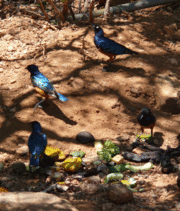
Superb Starlings enjoying left-over fruit
I also tried to photograph the birds from the kitchen window again today, but the area where I feed them is very awkward, being mostly in shadow and dappled light. So the photos are pretty awful…Roll on the birdbath (which is still being studiously ignored by all the birds!).
See more photos of birds enjoying the food I put out for them...
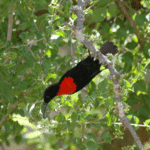
Male Hunters Sunbird
I took some better photos of the fabulous Hunters Sunbirds from our bedroom window – what incredible birds they are, with their deep, chocolate-black colouring, a flash of purple on the shoulder and a cap of iridescent green, all set off by the most unbelievable flaming red chests. I also snapped a couple of Bulbuls busy foraging in a commiphora tree, instead of tucking into our leftover bananas for a change!
See more images of resident Kulafumbi birds, including Hunters Sunbirds and many more...

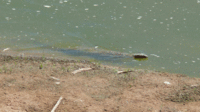
Monitor lizard swimming below our house
A huge Monitor Lizard (I saw one yesterday too – perhaps the same one?) was swimming in the river below the house this morning – it may have been hunting for frogs. When we first saw it, we thought it was a small crocodile but it turned out instead to be a big lizard with a long forked tongue constantly flashing in and out of his mouth, just like a snake. In fact, he was lucky not to have been attacked by a crocodile – crocodiles don’t like Monitor Lizards, which eat more crocodile eggs than any other creature.
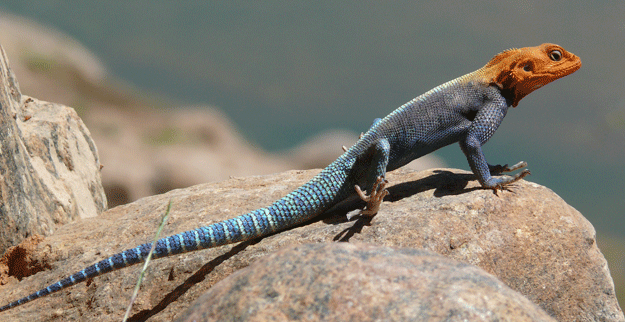
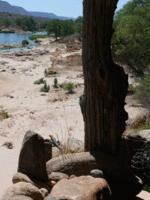
On top of the world!
Talking of lizards, today I had fun with our resident Red-headed Agama Lizard (above), who was proudly bobbing his head up and down on the edge of our balcony, displaying to all the world. Agama Lizard males always try to find a rock or tree stump from where to display, as the one with the highest spot has the advantage – so you can imagine that our Agama, with his vantage point on the edge of our first floor balcony, with a view right out over the Athi River thinks – probably with good reason – that he has the best spot in the whole of Africa!
Agama Lizard males can turn on and off their colour at will (a bit like chameleons). They mute their colour when they feel threatened and need to be better camouflaged. For comparison, here are a few images for comparison of when the male Agama is and when he is not displaying (click on any of the thumbnails for a larger view):
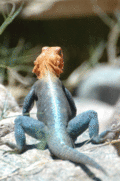
On display!
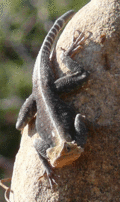
Not on display...
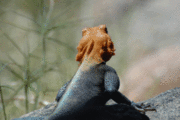
On display!
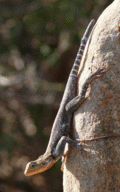
Not on display...

On display!
See more shots of lizards, and various other "small fry"...
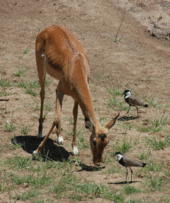
Impala & Spur-winged Plovers on sandbank
The impala were on the sandbank again, just below the house. It seems there are two herds which visit us here, as one herd is lead by a male with just one horn, so he’s easy to recognise. We saw him further up river this morning, and so the herd which a short time later was feeding below our house must have been a different one. The Spur-winged Plovers were busy foraging around the impala’s feet. For once, the Plovers were not trying to bully anyone, or chase anyone away from their patch – quite possibly because they have now successfully completed the rearing of their brood.

'Donald Duck Walk'
The Egyptian Geese – or should I say goslings – are growing up fast. I photographed them today in the lovely evening light – and took one shot in particular which amused us – of a gosling standing upright and flapping his tiny wings – rather Donald Duck-esque!
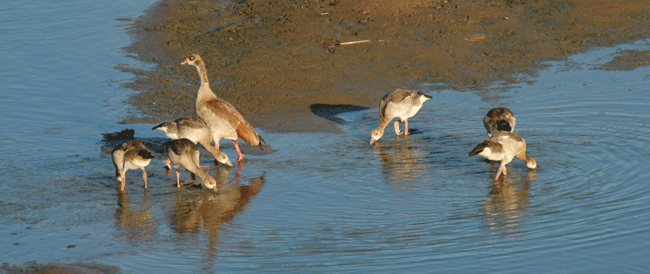
Keep up with the Egyptian Goose family through their dedicated photo gallery...

Dikkop pair on rock island
Another couple of ‘regulars’ were looking good in the evening light – a pair of Water Dikkops (also known as Thick-Knees). They are the ones who spend most of the day dozing on rock islands in the middle of the river, waking up at night and filling the nocturnal air with their beautiful mournful whistles. We saw them mating the other day, so no doubt they have a nest somewhere on the ground by now – I hope that they have not chosen a small island in the river, where the eggs would get taken by the water at the first sign of rain and rising river levels. Mind you, today was another sweltering day with no sign of rain whatsoever.
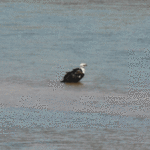
Young Fish Eagle washing in river
A young fish eagle we had not seen before turned up today. With his white and grey mottled colouring we can tell he is between 3-4 years old (when he first leaves the nest, he is brown all over). Soon he will assume the adult’s pristine white and brown-black plumage. (You can see more photos of him, along with a range of other birds of prey here.)He was having a good wash earlier in the day, and later on in the afternoon, when we wandered down to the far end of the sandbank again to ‘hippo bend’, he was there in a tree opposite us, with one of the adults. By the time we got there, the light was too poor for any decent shots of the hippos who were grumbling and back-biting at each other, as usual, but I took a couple of photos anyway. With the river so low, it seems that more and more hippos are being forced into the same deep-water areas, and things are getting a bit crowded and tense. Later, over dinner, I heard the sound of splashing water, and guessed a hippo was on his way out of the water below the house. With the moon approaching full again, there is already a lot of light at night, and without even using a flashlight, we were able to see the hippo walking in the shallows. As I write this, lying in bed, I can hear more hippos honking and grumbling at each other – or grumbling at something at any rate.
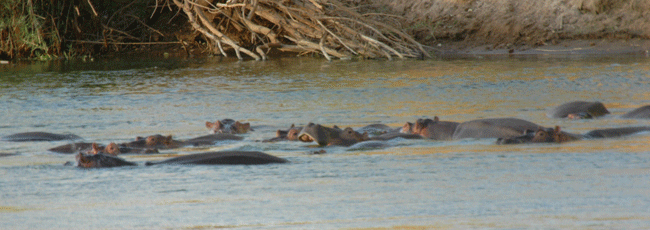
 Post a Comment |
Post a Comment |  Tanya | in
Tanya | in  "Our" Egyptian Goose Family,
"Our" Egyptian Goose Family,  Animals In House,
Animals In House,  Antelope (general),
Antelope (general),  Balcony Garden/Flowerbeds,
Balcony Garden/Flowerbeds,  Big Game (general),
Big Game (general),  Birdbath & Bird Table,
Birdbath & Bird Table,  Birds (eagles),
Birds (eagles),  Birds (general),
Birds (general),  Garden Trees & Plants,
Garden Trees & Plants,  Hippo,
Hippo,  Impala,
Impala,  Lizards,
Lizards,  Plants (general),
Plants (general),  River Level Low,
River Level Low,  Small Animals (general),
Small Animals (general),  Trees
Trees 




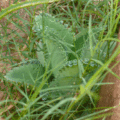
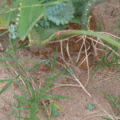
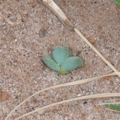
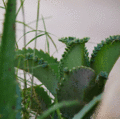

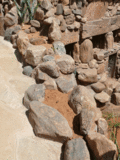
Reader Comments